If you drive a semi-trailer truck, you have to ensure your safety and the safety of other people on the roadway by checking the air tank on the truck and checking and opening the automatic air tank drain valve regularly. Doing so will help keep your brakes functional and keep moisture out of the service and supply line that leads to the braking system.
Removing Excess Moisture and Contaminants
Although an automatic air tank drain valve is designed to keep moisture out of the air tank on its own, it still is better to inspect any air tank drain valve, whether it is automatic or not, to ensure that everything is truly in working order . Routine drainage of the air tank with an automatic air tank drain valve should occur at least every 90 days for trucks that are driven moderately or every month for trucks and trailers that really rack up the mileage.
Spring-driven Brakes Offer a Safer Alternative to Older Trailer Designs
While new trailers for semi cabs feature spring brakes today, older trailers and converter dollies, which were built before 1975, do not offer this feature. Instead, emergency brakes are used that are operated with the air that has been stored in a trailer air tank.
Braking Processes of Older Trailers
Therefore, the emergency brakes operate when the air tank is filled with air. If air pressure is lost in the line, the emergency brakes operate. Because these older trailers do not feature a parking brake, the emergency brakes kick in when the trailer is disconnected. As long as there is air pressure in the air tank, the brakes are designed to hold.
Therefore, if you are driving a truck with an older model trailer, you need to use wheel chocks for parking the trailer. Otherwise, you can forego the practice if you are hauling a load with a trailer that features a spring brake design.
How the Spring Brake Works
All the parts of an air brake system for a semi are based on the transfer of air. The spring brakes that are used today, in addition to the air compressor, air governor, air tank and automatic air tank drain valve, actuates the parking brake.
As a result, the spring brake operates in two ways. Pressure is first applied to the spring side, permitting disengagement of the parking brake. The required amount of pressure will differ. However, the spring on the system is totally decompressed at a weight of 20 pounds. If the spring is decompressed fully, the parking brake is applied. Therefore, spring brakes contain two air chambers – one which releases the spring on the brake and another chamber that allows the driver to brake. Needless to say, safety has been enhanced with the newer spring brake.

